|
This Site:
Discovery of America
The Explorers
Post Columbian Exploration
Thirteen Original Colonies
Colonization of America
Colonial Life
Colonial Days and Ways
Independence Movement
The Patriots
Prelude to War
Revolutionary War
Revolutionary War Battles
Overview of Revolutionary War
Revolutionary War
Timeline
Civil War
American Flag
Mexican War
Republic of Texas
Indians
|
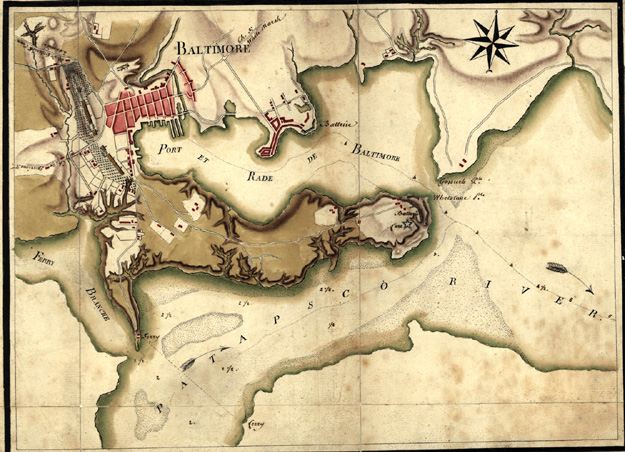
Baltimore
Maryland; History Of.—Under
authority of an act of the Assembly, Aug. 8, 1729, a town of sixty
acres was created, and in the following year it was officially laid
out and named Baltimore in honor of Cecil Calvert (see
BALTIMORE, LORDS) . The
territory covered by the town was that now bounded approximately by
Liberty, Saratoga, and Frederick streets and the Basin or inner
harbor. Two years later Jones's Town, subsequently Old Town, east of
the falls, was laid out. The first parish church, on the site of the
present corner of Saratoga and Charles streets, was begun in 1730
and finished in 1739. In 1745 Baltimore began its course of
expansion by having Jones's Town incorporated with it, and in 1753
it was again enlarged by the absorption of thirty-two acres of what
was known as Coles's Harbor. At this time Baltimore Town contained
25 houses and 200 inhabitants. Charles Carroll erected Mount Clare
house, using imported brick, in 1754, and the town received its
first immigrants—a body of Acadian exiles.
The year 1768 was one of large political significance, the town
being then constituted the countyseat. The first issue of the first
newspaper, the Maryland Journal and Baltimore Advertiser, came from
the press on Aug. 20, 1773, and in the same year a stage route to
Philadelphia was opened, the first Methodist meetinghouse was
erected, and the first display of popular benevolence was made, the
citizens sending a goodly supply of corn, rye, and bread to the poor
of Boston. In 1775 the town contained 564 houses and 5,934
inhabitants.
Revolutionary War Period
During the Revolutionary War period the town
escaped the horrors of hostile strife, yet had several exciting
incidents connected therewith. The
Continental Congress
was in session here from December 20, 1776, to Jan. 20, 1777,
sitting in the hall on the corner of Baltimore and Liberty streets.
On March 25, 1777, a political riot occurred, caused by a body of
members of the Whig Club, excited by an article in the Maryland
Journal praising King George and the British Parliament, storming
Mr. Goddard, the editor, in his office. In March of the following
year Count Pulaski organized his famous corps here. The first
connection between the town and the national government was made in
1780, when a custom-house was erected. In 1781 the paving of the
streets was begun ; in 1784 the streets were first lighted with
oil-lamps; on Oct. 5, 1786, the first destructive flood occurred; in
1791 the Bank of Maryland was organized; and in the summer of 1794
the town was first visited by an epidemic–yellow fever. A second
epochal year was 1796, when, on Dec. 31, the town was incorporated
as a city. It then had 20,000 inhabitants. James Calhoun, the first
mayor, was elected Jan. 16, 1797. Water was first supplied through
castiron pipes in May, 1807.
War of 1812
The part borne by Baltimore in the war of 1812–15
began on June 12, 1812, when a mob attacked the office of the
Federal Republican., because of the publication in it of an article
denouncing the declaration of war against England. On July 27
following, the mob resumed the attack and destroyed the office and
its contents. On Sept. 12, 1814, a British force, under General
Robert Ross, advanced against the city. They were met by a defensive
column at North Point, where an engagement was fought in which the
British commander was killed. Finding the city much more strongly
fortified than they had anticipated, the British soldiers retired
from their position, leaving the task of punishment to their fleet,
which bombarded Fort McHenry unsuccessfully on the following day.
During the attack on the fort Francis Scott Key, a witness of the
action, composed " The Star-spangled Banner," and it was printed in
the Baltimore American and Daily Advertiser on Sept. 21, 1814. The
cornerstones of the Washington and Battle monuments were laid in
1815, the latter on the anniversary of the North Point engagement.
Another increase in the area of the city was made
in 1816, when a number of precincts with a combined population of
16,000 were annexed. On Aug. 8, 1817, a freshet at Jones's Falls
overflowed the " Meadows " section to a depth of from ten to fifteen
feet. American Odd-Fellowship had its birth in Baltimore on April
13, 1819, when Washington Lodge, No. 1, was organized at Fell's
Point through the efforts of Thomas Kildey. The lodge received its
charter from Duke of York Lodge, of Preston, England, in February
following. In 1820 the first public building and the first private
house were lighted with gas; the first building of all to be so
improved was Peale's Museum, in 1816. The city had its first serious
visitation of fire on June 23, 1822, three lumberyards and from
twenty-five to thirty buildings, mostly warehouses, being burned. An
evidence of the financial prosperity of the citizens in this period
is shown by the fact that in March, 1827, when subscription books
for stock of the Baltimore & Ohio Railroad were opened, 22,000
persons subscribed $4,178,000. This popular expression of confidence
both in the promoters and the project was so effective that on July
4 of the following year the' foundation-stone of the rail-road was
laid by the Masonic Grand Lodge of Maryland, assisted by the
venerable Charles Carroll, of Carrollton.
Centinnial
Baltimore celebrated the centennial of its
official creation, Aug. 8, 1829, and in the following month
dedicated its first public school. It had its second epidemic –this
time of cholera–in 1832; its first bank failure in 1835; its fourth
riot, because of the bank failure, in 1835; and its second freshet
at Jones's Falls in 1837, when nineteen lives were lost, and
Harrison and Frederick streets were flooded to the depth of ten
feet. Foreign commercial intercourse began on May 20, 1838, when the
City of Kingston, the first steam-vessel from Baltimore to Europe
direct, left the port. The principal occurrences in the next ten
years were the explosion of the boiler of the steamer Medora, just
as she was about to start on her trial trip, April 15, 1842, in
which twenty-seven persons lost their lives and forty were injured,
and the reception of the first magnetic telegraph communication from
Washington, " What hath God wrought," May 27, 1844. On May 28, 1848,
the city was visited by another conflagration, breaking out in a
cotton-factory in Lexington Street, and destroying sixty dwellings.
The next five years marked the death of Edgar Allan Poe (1849), the
arrival of Jenny Lind (1850), the reception of Louis Kossuth (1851),
and the arrival from Louisville, Ky., of the remains of Junius
Brutus Booth (1852). The most serious calamity occurred on July 4,
1854, when thirty persons were killed and about 100 injured by a
collision of an excursion with an accommodation train near the Relay
House. On June 18, 1860, the adjourned Convention of Democratic
delegates who had first assembled in Charleston, S. C., met in
Baltimore under the chairmanship of Caleb Cushing. A number of
delegates who had withdrawn from the Charleston Convention and
reassembled in Richmond claimed the right to sit in the Baltimore
Convention, and the chairman, declining to decide the delicate
question, referred it to t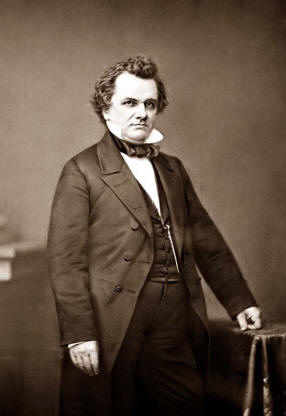 he
Convention. This action precipitated an acrimonious debate. The case
of the contesting delegates was referred to the Committee on
Credentials, which, owing to diversities of opinion, submitted two
reports on the 21st, which gave rise to another heated debate and
the advocacy of the reopening of the slave trade. On the following
day the majority report was adopted; the places of most of the
seceders, who were unseated, were filled by Douglas men ; another
withdrawal of Southern delegates occurred; and finally Mr. Cushing
and a majority of the Massachusetts delegation also withdrew.
Governor David Tod, of Ohio, succeeded Mr. Cushing as chairman, and
the Convention proceeding to ballot for a Presidential candidate,
Stephen A. Douglas, of Illinois, was nominated for President, and
Herbert V. Johnson, of Georgia, for Vice-President. The Convention
adjourned on June 23. he
Convention. This action precipitated an acrimonious debate. The case
of the contesting delegates was referred to the Committee on
Credentials, which, owing to diversities of opinion, submitted two
reports on the 21st, which gave rise to another heated debate and
the advocacy of the reopening of the slave trade. On the following
day the majority report was adopted; the places of most of the
seceders, who were unseated, were filled by Douglas men ; another
withdrawal of Southern delegates occurred; and finally Mr. Cushing
and a majority of the Massachusetts delegation also withdrew.
Governor David Tod, of Ohio, succeeded Mr. Cushing as chairman, and
the Convention proceeding to ballot for a Presidential candidate,
Stephen A. Douglas, of Illinois, was nominated for President, and
Herbert V. Johnson, of Georgia, for Vice-President. The Convention
adjourned on June 23.
Baltimore in the Civil War
Because of subsequent events it may be noted here
that when the larger part of the
Massachusetts delegation withdrew from the Convention
Benjamin F. Butler explained the action in the following
vigorous language: " We put our withdrawal before you upon the
simple ground, among others, that there has been a withdrawal, in
part, of a majority of the States, and, further (and that, perhaps,
more personal to myself) , upon the ground that I will not sit in a
convention where the African
slave trade - which is piracy by the laws of my country-is
approvingly advocated."
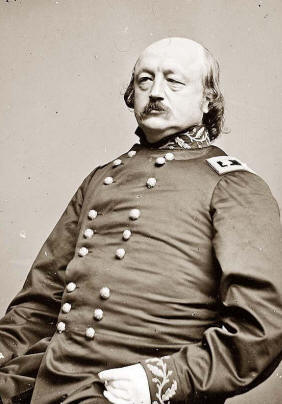 The
results of the Baltimore Convention thickened rather than cleared
the political atmosphere. Party and sectional feelings were alike
stirred to fever heat, and the election of Abraham Lincoln furnished
the fuel on which the flames soon burst forth. Early in January,
1861, Governor John A. Andrew, of Massachusetts, tendered a body of
State troops to the national government for its protection.
Fort Sumter was attacked, and on the day that the President's
call for volunteers was issued, Governor Andrew was telegraphed to
send twenty companies of militia to Washington immediately. Four
regiments were at once brigaded and placed under the command of
Benjamin F. Butler, just commissioned a brigadier-general. On Jan.
16, United States Senator Wilson telegraphed from Washington for
four regiments. They were in readiness to start directly the
necessary order was received, and the 6th Regiment, under Colonel
Jones, was dispatched first, by way of New
York, Philadelphia, and Baltimore. The regiment at this time
consisted of thirteen companies, two having been added to the
original force. The
results of the Baltimore Convention thickened rather than cleared
the political atmosphere. Party and sectional feelings were alike
stirred to fever heat, and the election of Abraham Lincoln furnished
the fuel on which the flames soon burst forth. Early in January,
1861, Governor John A. Andrew, of Massachusetts, tendered a body of
State troops to the national government for its protection.
Fort Sumter was attacked, and on the day that the President's
call for volunteers was issued, Governor Andrew was telegraphed to
send twenty companies of militia to Washington immediately. Four
regiments were at once brigaded and placed under the command of
Benjamin F. Butler, just commissioned a brigadier-general. On Jan.
16, United States Senator Wilson telegraphed from Washington for
four regiments. They were in readiness to start directly the
necessary order was received, and the 6th Regiment, under Colonel
Jones, was dispatched first, by way of New
York, Philadelphia, and Baltimore. The regiment at this time
consisted of thirteen companies, two having been added to the
original force.
Blood in the Streets of Baltimore
News of the approach of these troops, followed by
details of the destruction of the arsenal and armory at Harper's
Ferry, created intense excitement in Baltimore, and by the time the
train bearing the Massachusetts soldiers reached the President
Street station near noon on April 19, a crowd of about 500 excited
men were waiting to receive them. While horses were being attached
to the cars to draw them to the Camden Street station this crowd was
increased to about 2,000 men, who followed the cars to the station,
where another large one had gathered. On reaching Pratt Street the
crowd began shouting for Jefferson Davis and the Southern
Confederacy, and when near the corner of Gay Street, where there was
a large heap of stones, they broke loose from all restraint and
hurled these missiles on the soldier-laden cars as they passed.
Every window was demolished, and several soldiers were injured.
Failing to tear up the track, the crowd made a
barricade across the street. The troops back of this, comprising
four companies, then alighted from the cars for the purpose of
marching the remaining distance to the Camden Street station. As
they started in close order, the crowd, led by a man bearing a
Confederate flag on a pole, fell upon them, shouting that they
should never pass through the city alive, and hurling bricks and
stones into their ranks. The troops then began advancing on the "
double quick "; the attack-became more furious; several soldiers
were knocked down and robbed of their guns; suddenly shots began to
be fired from the crowd. Up to this time the troops had offered no
resistance, but when it was evident that the crowd was deter-mined
on wholesale murder in order to prevent the passage of the troops,
the latter prepared to defend themselves.
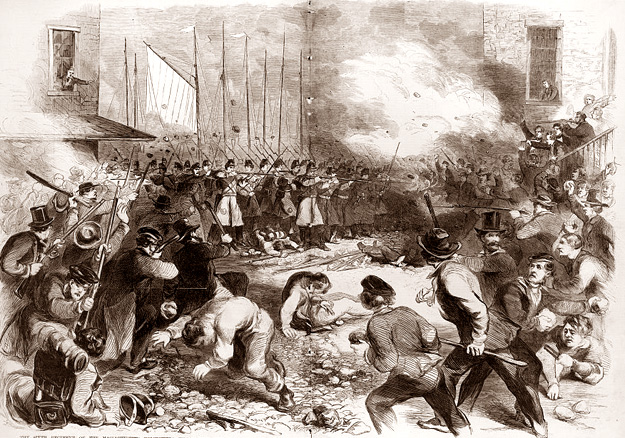
Riot
on the Streets of Baltimore
On reaching Gay Street, where the crowd had
increased to 10,000 men, the troops turned and fired at random into
their assailants. This greatly intensified the excitement. The mayor
tried in vain to quell the riot, and the troops were left to fight
their way through to the station. The severest of the fighting was
in Pratt Street, between Gay and Bowley's wharf, near Calvert
Street. From the beginning of the riot till the troops reached the
Camden Street station, three of their number were killed outright,
one mortally wounded, eight were seriously injured, and several
others slightly. Nine citizens were killed, but how large the number
of wounded was will never be known. As the train proceeded on its
journey it was followed by the crowd for more than a mile, and was
frequently fired into from the hills on the way. The troops reached
their destination that evening, and were quartered in the Senate
Chamber.
A meeting of some State and city officials was
held the night of the riot, and Governor Hicks was besought for
permission to destroy the bridges on lines of railroad over which it
was believed other troops might be transported to Washington.
Governor Hicks refused, but Marshal Kane, Mayor Brown, and President
Howard of the Board of Police, organized gangs of men, who destroyed
the Canton, Gunpowder, Bush, and Cockeysville bridges, and cut all
telegraph wires leading out of the city, excepting the one to
Harper's Ferry, then held by the Confederates. Thus all
communication by railroad and telegraph between the national capital
and the Northern States was severed.
The State and city authorities then undertook to
obtain a pledge from the President that no more troops should be
permitted to pass through the city, but he replied in substance : "
I must have troops for the defense of the capital. The Carolinians
are now marching across Virginia to seize the capital and hang me.
What am I to do? I must have troops, I say; and as they can neither
crawl under Maryland nor fly over it, they must come across it."
Several delegations failed to swerve the President from his
determination, and, finding this scheme fruitless, the authorities
planned other measures to accomplish their purpose, but were
frustrated by General Butler, who, ascertaining that Baltimore was
in his department, organized an expedition that took possession of
the Relay House on the Baltimore & Ohio Railroad, nine miles from
the city, on the morning of May 5. An immense Union meeting had been
held in the city on the previous evening, and from its leaders
General Butler obtained such full information concerning local
conditions that he was enabled to inaugurate energetic measures at
once. On May 14 by a feint movement of troops he took possession of
the city and established his headquarters on Federal Hill. Soon
afterward the President commissioned him a major-general and
assigned him to the command of a more extended military district-the
Department of Virginia, which included
Fort Monroe.
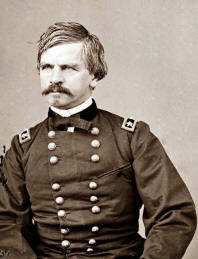 General
Butler was succeeded in command of the Department of Annapolis, with
headquarters in Baltimore, by
General Nathaniel P. Banks, who, in June, became satisfied that
Marshal Kane and the Board of Police were in league with the
Confederates in a combination to assist General Beauregard to seize
the national capital by preventing the passage of Union soldiers
through the State and aiding Marylanders to cross into Virginia to
the Confederate army. General Banks arrested Marshal Kane and the
police commissioners, organized a new police force of loyal men, and
soon had the city under effective control. General
Butler was succeeded in command of the Department of Annapolis, with
headquarters in Baltimore, by
General Nathaniel P. Banks, who, in June, became satisfied that
Marshal Kane and the Board of Police were in league with the
Confederates in a combination to assist General Beauregard to seize
the national capital by preventing the passage of Union soldiers
through the State and aiding Marylanders to cross into Virginia to
the Confederate army. General Banks arrested Marshal Kane and the
police commissioners, organized a new police force of loyal men, and
soon had the city under effective control.
Baltimore Fire
On July 25, 1873, the city was visited by a
conflagration in which two churches, three school-houses, and 108
other buildings were destroyed, causing a loss of $750,000, and on
Sept. 2, 1888, another fire, in Hopkins Place, caused a property
loss of $2,000,000, and the lives of several firemen. Its greatest
disaster by fire, however, occurred on Feb. 7-8, 1904, when a
territory measuring twelve by nine full city blocks and extending
for more than a mile of water front was left in smoking ruins. The
fire was in the business section, and only the City Hall, Court
House, and United States Government Building escaped. A remarkable
feature of the disaster was the fact that the casual-ties were
limited to one fireman killed and less than fifty persons injured.
In the adjustment of insurance claims the property loss was placed
at $45,000,000, and the insurance loss at about $30,000,000. |

 he
Convention. This action precipitated an acrimonious debate. The case
of the contesting delegates was referred to the Committee on
Credentials, which, owing to diversities of opinion, submitted two
reports on the 21st, which gave rise to another heated debate and
the advocacy of the reopening of the slave trade. On the following
day the majority report was adopted; the places of most of the
seceders, who were unseated, were filled by Douglas men ; another
withdrawal of Southern delegates occurred; and finally Mr. Cushing
and a majority of the Massachusetts delegation also withdrew.
Governor David Tod, of Ohio, succeeded Mr. Cushing as chairman, and
the Convention proceeding to ballot for a Presidential candidate,
Stephen A. Douglas, of Illinois, was nominated for President, and
Herbert V. Johnson, of
he
Convention. This action precipitated an acrimonious debate. The case
of the contesting delegates was referred to the Committee on
Credentials, which, owing to diversities of opinion, submitted two
reports on the 21st, which gave rise to another heated debate and
the advocacy of the reopening of the slave trade. On the following
day the majority report was adopted; the places of most of the
seceders, who were unseated, were filled by Douglas men ; another
withdrawal of Southern delegates occurred; and finally Mr. Cushing
and a majority of the Massachusetts delegation also withdrew.
Governor David Tod, of Ohio, succeeded Mr. Cushing as chairman, and
the Convention proceeding to ballot for a Presidential candidate,
Stephen A. Douglas, of Illinois, was nominated for President, and
Herbert V. Johnson, of  The
results of the Baltimore Convention thickened rather than cleared
the political atmosphere. Party and sectional feelings were alike
stirred to fever heat, and the election of Abraham Lincoln furnished
the fuel on which the flames soon burst forth. Early in January,
1861, Governor John A. Andrew, of Massachusetts, tendered a body of
State troops to the national government for its protection.
The
results of the Baltimore Convention thickened rather than cleared
the political atmosphere. Party and sectional feelings were alike
stirred to fever heat, and the election of Abraham Lincoln furnished
the fuel on which the flames soon burst forth. Early in January,
1861, Governor John A. Andrew, of Massachusetts, tendered a body of
State troops to the national government for its protection.

 General
Butler was succeeded in command of the Department of Annapolis, with
headquarters in Baltimore, by
General
Butler was succeeded in command of the Department of Annapolis, with
headquarters in Baltimore, by